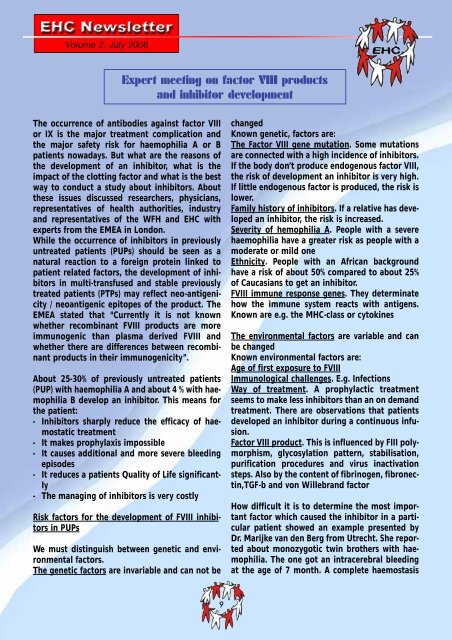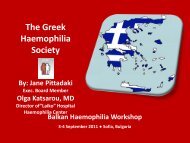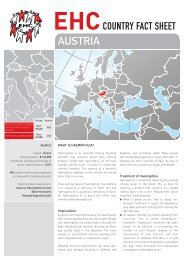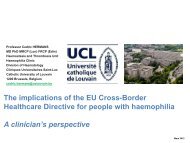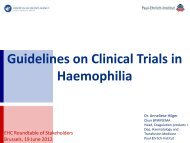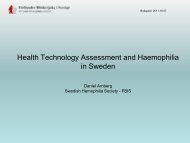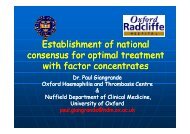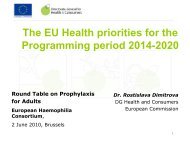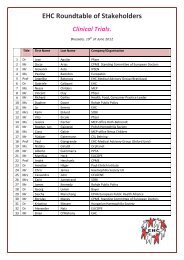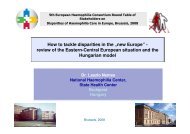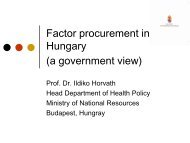Volume 2, July 2006 - EHC
Volume 2, July 2006 - EHC
Volume 2, July 2006 - EHC
- No tags were found...
You also want an ePaper? Increase the reach of your titles
YUMPU automatically turns print PDFs into web optimized ePapers that Google loves.
<strong>Volume</strong> 2, <strong>July</strong> <strong>2006</strong>Expert meeting on factor VIII productsand inhibitor developmentThe occurrence of antibodies against factor VIIIor IX is the major treatment complication andthe major safety risk for haemophilia A or Bpatients nowadays. But what are the reasons ofthe development of an inhibitor, what is theimpact of the clotting factor and what is the bestway to conduct a study about inhibitors. Aboutthese issues discussed researchers, physicians,representatives of health authorities, industryand representatives of the WFH and <strong>EHC</strong> withexperts from the EMEA in London.While the occurrence of inhibitors in previouslyuntreated patients (PUPs) should be seen as anatural reaction to a foreign protein linked topatient related factors, the development of inhibitorsin multi-transfused and stable previouslytreated patients (PTPs) may reflect neo-antigenicity/ neoantigenic epitopes of the product. TheEMEA stated that “Currently it is not knownwhether recombinant FVIII products are moreimmunogenic than plasma derived FVIII andwhether there are differences between recombinantproducts in their immunogenicity”.About 25-30% of previously untreated patients(PUP) with haemophilia A and about 4 % with haemophiliaB develop an inhibitor. This means forthe patient:- Inhibitors sharply reduce the efficacy of haemostatictreatment- It makes prophylaxis impossible- It causes additional and more severe bleedingepisodes- It reduces a patients Quality of Life significantly- The managing of inhibitors is very costlyRisk factors for the development of FVIII inhibitorsin PUPsWe must distinguish between genetic and environmentalfactors.The genetic factors are invariable and can not bechangedKnown genetic, factors are:The Factor VIII gene mutation. Some mutationsare connected with a high incidence of inhibitors.If the body don’t produce endogenous factor VIII,the risk of development an inhibitor is very high.If little endogenous factor is produced, the risk islower.Family history of inhibitors. If a relative has developedan inhibitor, the risk is increased.Severity of hemophilia A. People with a severehaemophilia have a greater risk as people with amoderate or mild oneEthnicity. People with an African backgroundhave a risk of about 50% compared to about 25%of Caucasians to get an inhibitor.FVIII immune response genes. They determinatehow the immune system reacts with antigens.Known are e.g. the MHC-class or cytokinesThe environmental factors are variable and canbe changedKnown environmental factors are:Age of first exposure to FVIIIImmunological challenges. E.g. InfectionsWay of treatment. A prophylactic treatmentseems to make less inhibitors than an on demandtreatment. There are observations that patientsdeveloped an inhibitor during a continuous infusion.Factor VIII product. This is influenced by FIII polymorphism,glycosylation pattern, stabilisation,purification procedures and virus inactivationsteps. Also by the content of fibrinogen, fibronectin,TGF-band von Willebrand factorHow difficult it is to determine the most importantfactor which caused the inhibitor in a particularpatient showed an example presented byDr. Marijke van den Berg from Utrecht. She reportedabout monozygotic twin brothers with haemophilia.The one got an intracerebral bleedingat the age of 7 month. A complete haemostasis9


